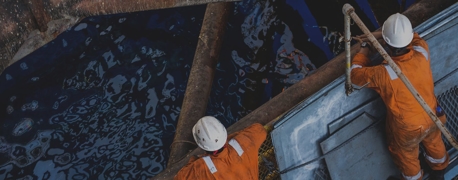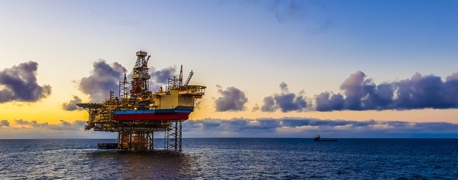High Seas, High Risks: America’s Deadliest Fisheries

April 2, 2001—It was a seemingly ordinary night in the frigid expanse of the Bering Sea. A 92-foot fishing trawler named the Arctic Rose and her Seattle-based crew of 15 were in the third month of their four-month trip in the fishing grounds off the Alaskan coast, when the vessel suddenly vanished.
There was no distress call. It was as if the Arctic Rose had fallen off the edge of the world, consumed by the sea in a single, catastrophic moment.
The only clue was a ping from an emergency locator. When the Alaskan Rose, sister ship to the Arctic Rose, arrived at the site in the morning, just an oil slick and the body of the ship’s captain, still in his red survival suit, remained.
The U.S. Coast Guard later located the sunken trawler upright at the bottom of the Bering Sea in 428 feet of freezing water, but investigators could not determine with confidence what had caused the vessel to sink. Video footage of an open watertight door, however, led to the conclusion that the Arctic Rose had flooded in less than five minutes, giving the crew no time to escape.
The loss of the Arctic Rose is one of the deadliest commercial fishing accidents in U.S. history, but it is not an isolated incident. It is a horrific example of the hazards that lurk in one of the world’s most dangerous occupations.
The Most Dangerous Regions & Catches for U.S. Fishermen
The fatality rate in commercial fishing is 75.2 per 100,000 full-time workers, a staggering 21 times higher than the national average of 3.6. TV shows like The Deadliest Catch and movies like The Perfect Storm have made more people familiar with the risks that fishermen face, but what is the stark reality? Which regions are the most hazardous? Which catches are truly the deadliest?
Analyzing NIOSH statistics from 2013 to 2022 reveals America’s most hazardous fisheries. The Gulf of Mexico, known for its shrimp fishing, witnessed 36 deaths, making it one of the deadliest areas. Most fatalities were due to falls overboard and vessel disasters. Alaska, famous for its salmon and cod fishing, accounted for 52 deaths across these two fisheries. On the East Coast, scallop fishing led to 19 deaths, while crab and lobster fishing accounted for a combined 24 fatalities. The West Coast, especially known for Dungeness crab fishing, saw 16 deaths, primarily from vessel disasters.
Vessel disasters are the leading cause of death in commercial fishing, accounting for 37% of fatalities from 2013 to 2022. These include events like flooding, being struck by large waves, and collisions. The statistics show that heavy weather was a factor in 51% of these disasters.
Falls overboard are the second most common cause, responsible for 33% of deaths. Alarmingly, 66% of these incidents were not witnessed, highlighting the importance of crew supervision as well as personal flotation devices and effective man-overboard alarms (and responses).
Onboard fatalities accounted for 20% of fatalities, ranging from gear entanglement and drug overdoses to asphyxiation and even suicide and homicide.
By region, the East Coast led with 36% of the fatalities, followed by Alaska with 27%, the Gulf of Mexico with 22%, the West Coast with 13%, and Hawaii with 2%. This distribution highlights the varying dangers in different fishing environments.
Fatality Rates of American Fisheries
To better understand where commercial fishing risks are highest, it's crucial to look beyond the sheer number of deaths and consider fatality rates. This approach takes into account the differences in the number of vessels, fishermen, and season lengths among various commercial fishing fleets.
The most recent information regarding commercial fishing fatality rates, by region, was calculated by NIOSH and involves an analysis of statistics from 2005-2014. According to the Commercial Fishing Fatality Summary: Gulf of Mexico Region, while the Gulf of Mexico shrimp fleet experienced the highest number of fatalities from 2005 to 2014, with 48 crew member deaths, this statistic alone is misleading. Due to its large workforce, this fishery actually had the nation’s lowest fatality rate.
NIOSH uses a specific formula to calculate fatality rates in commercial fishing: the number of vessels, multiplied by crew per vessel, multiplied by the number of operating days, and then adjusted for a standard 40-hour workweek. This formula helps to standardize the risk assessment across different fisheries. In NIOSH’s Commercial Fishing Fatality Summary, this rate is presented per 10,000 full-time equivalent (FTE) workers as opposed to the national rate measured per 100,000 FTE workers. This supports the smaller sample size available for commercial fishing statistics.
Looking at the commercial fishing fatality rates from 2005-2014, we get a clear picture of America’s deadliest catches:
- Northeast Multispecies Groundfish (East Coast): 30
- Atlantic Clam/Quahog Dredge (East Coast): 22.5
- Atlantic Snapper/Grouper (East Coast): 14.5
- Multispecies Groundfish (West Coast):14.5
- Salmon Set Gillnet (Alaska): 12
- Non-Tribal Dungeness Crab (West Coast): 10.5
- Atlantic Squid (East Coast): 10.5
- Atlantic Scallop (East Coast): 10.5
- Atlantic Flounder/Scup/Black Sea Bass (East Coast): 10
- Bering Sea Crab (Alaska): 10
- Shrimp (Gulf of Mexico): 2.3
Note: These are approximate fatality rates, per 10,000 FTE fishermen.
East Coast: Northeast Groundfish, Clam/Quahog Dredge
The top three deadliest fisheries by fatality rate were all on the East Coast.
Northeast Multispecies Groundfish: This fishery, involving the catch of various groundfish such as cod, haddock, and flounders, faces challenges such as rough Atlantic weather conditions and the complex nature of managing multiple species with different fishing regulations and behaviors.
Atlantic Clam/Quahog Dredge: This fishery harvests clams and quahogs from the ocean floor using heavy dredging equipment. The physical demands of this type of fishing, combined with the unpredictable Atlantic Ocean, contribute to its high fatality rate.
Atlantic Snapper/Grouper: Targeting species like snapper and grouper, this fishery involves long hours of line fishing in deep waters. The risks include sudden weather changes and the dangers associated with handling large catches and heavy gear.
West Coast: Multispecies Groundfish & Dungeness Crab
On the West Coast, the two deadliest catches by fatality rate were groundfish and Dungeness crab.
Multispecies Groundfish: Similar to its East Coast counterpart, this fishery targets a variety of groundfish species, including sole, rockfish, flounder, cod, and perch. Fishermen in this region face the Pacific Ocean's vast and often treacherous waters, which can be unpredictable and pose significant risks, especially during stormy weather.
Non-Tribal Dungeness Crab: This fishery is known for its lucrative catches but also for the hazardous conditions of the Pacific, including rogue waves and strong currents. The physical labor of hauling crab pots and navigating through challenging maritime conditions contributes to its high fatality rate.
Alaska: Salmon Set Gillnet
In Alaskan waters, salmon set gillnet was the region’s deadliest fishery. This method involves setting stationary nets in which salmon become entangled. The Alaskan waters, known for their frigid temperatures and sudden storms, pose significant dangers. Additionally, the remote locations of these fisheries can delay rescue efforts in emergencies, increasing the risk for fishermen.
Improving Safety in America’s Deadliest Regions & Catches
Despite these grim statistics, there's a silver lining. Commercial fishing fatalities have decreased by 52% from 2000 to 2022. This decline suggests that safety measures and awareness are improving, but there's still a long way to go. Ultimately, the responsibility lies with vessel owners and operators of commercial fishing operations. Whether through greater adherence to weather warnings, retiring aging fishing vessels, maintaining proper watch, or providing personal flotation devices and requiring their use, these parties must step up and prioritize the well-being of their crews.
When navigating America’s deadliest fisheries, safety must come first. No matter what.


